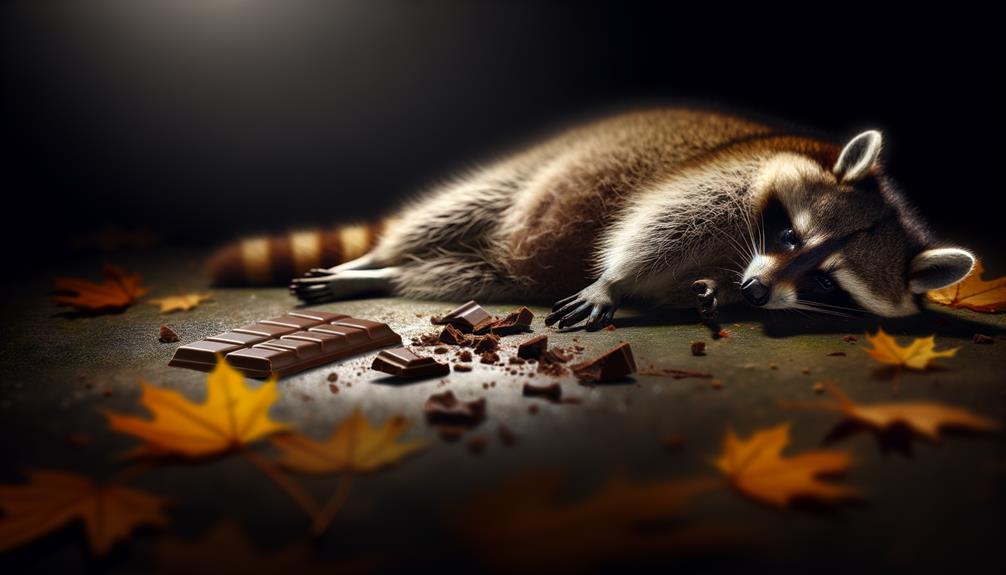How to Keep Your Raccoon Safe from Eating Chocolate
Raccoons should not consume chocolate due to the poisonous effects of theobromine and caffeine, which their bodies metabolize very slowly. This can result in a harmful build-up, leading to symptoms like vomiting, diarrhea, hyperactivity, tremors, and seizures.
Darker chocolates pose a higher risk due to increased concentrations of these toxic compounds. Immediate veterinary intervention is essential when symptoms of chocolate poisoning appear to prevent severe complications.
For a more detailed understanding of raccoons' metabolic limitations and safe dietary alternatives, exploring further information is advantageous.

Key Takeaways
- Raccoons should not eat chocolate as it contains theobromine and caffeine, which are highly toxic to them.
- Theobromine toxicity in raccoons can cause vomiting, diarrhea, seizures, and rapid heart rate.
- Dark chocolate is particularly dangerous for raccoons due to higher concentrations of theobromine and caffeine.
- Raccoons metabolize theobromine and caffeine slowly, leading to toxic build-up and severe health issues.
- Safe alternatives like fruits, vegetables, and proteins should be provided to raccoons to avoid the risk of chocolate poisoning.
Chocolate and Raccoons

Raccoons, like many other mammals, are unable to properly metabolize theobromine, a compound found in chocolate, making its consumption potentially toxic for them. Theobromine is a methylxanthine alkaloid that affects the central nervous system, cardiovascular system, and respiratory system of raccoons. Due to their inefficient metabolic pathways for processing this compound, even small amounts of chocolate can lead to symptoms such as vomiting, diarrhea, hyperactivity, tremors, and seizures. In severe cases, theobromine toxicity can result in fatal outcomes.
Understanding the metabolic limitations of raccoons is vital for preventing accidental ingestion of chocolate. It is essential for those who handle or care for raccoons to be aware of the risks associated with chocolate consumption to safeguard their well-being.
Toxic Ingredients
Several ingredients commonly found in chocolate, such as theobromine and caffeine, are highly toxic to raccoons. Theobromine is a methylxanthine compound structurally similar to caffeine, but with a longer half-life in the body of non-human animals. When ingested, these substances affect the central nervous system, cardiovascular system, and respiratory system.
Raccoons metabolize these compounds much more slowly than humans, leading to a rapid build-up of toxic levels even with small amounts of chocolate. The toxicity is dose-dependent, meaning that the severity of the adverse effects increases with the quantity consumed. Additionally, darker chocolates contain higher concentrations of theobromine and caffeine, posing a greater risk.
Understanding these toxic ingredients is important for safeguarding raccoon health.
Symptoms of Poisoning

Upon ingestion of chocolate, raccoons may exhibit symptoms indicative of poisoning, including gastrointestinal distress such as vomiting and diarrhea.
Neurological manifestations like seizures and tremors may also occur, reflecting central nervous system involvement.
Additionally, theobromine toxicity can lead to cardiovascular complications, particularly a rapid heart rate.
Vomiting and Diarrhea
Experiencing vomiting and diarrhea can be indicative of chocolate poisoning in raccoons, as these symptoms reflect the gastrointestinal distress caused by the theobromine and caffeine present in chocolate. Theobromine, a methylxanthine compound, is metabolized slowly in raccoons, leading to toxic accumulation.
Gastrointestinal symptoms such as vomiting and diarrhea serve as the body's attempt to expel these harmful substances. Vomiting may present soon after ingestion, while diarrhea can follow as the digestive tract becomes irritated. Both symptoms can lead to dehydration, further complicating the raccoon's condition.
Prompt veterinary intervention is essential to manage these symptoms and prevent more severe systemic effects. Monitoring hydration levels and providing supportive care are key steps in addressing chocolate toxicity in raccoons.
Seizures and Tremors
Seizures and tremors in raccoons are pivotal neurological symptoms indicative of advanced chocolate poisoning, resulting from the toxic effects of theobromine and caffeine on the central nervous system. These symptoms are alarming and warrant immediate veterinary attention.
The severity and progression of these symptoms can be observed in distinct stages:
- Initial muscle twitching: Subtle and sporadic, often first noticed in the limbs.
- Involuntary tremors: More consistent and pronounced, spreading through the body.
- Severe seizures: Characterized by uncontrollable muscle contractions and convulsions.
- Loss of motor control: Resulting in disorientation, imbalance, and potential collapse.
Understanding these symptoms is pivotal for timely intervention and potentially saving the life of the affected raccoon.
Rapid Heart Rate
A rapid heart rate, or tachycardia, is a vital symptom of chocolate poisoning in raccoons, stemming from the stimulatory effects of theobromine and caffeine on the cardiovascular system.
These methylxanthines increase the release of norepinephrine and adrenaline, leading to heightened cardiac activity.
In raccoons, tachycardia manifests as an abnormally fast heartbeat, which can be detected through veterinary examination.
This condition places significant strain on the heart and circulatory system, potentially resulting in arrhythmias, heart failure, or sudden death if left untreated.
Monitoring heart rate and seeking immediate veterinary care are essential steps in managing chocolate toxicity.
Rapid intervention can mitigate severe cardiovascular complications, thereby improving the prognosis for the affected raccoon.
Safe Alternatives
While chocolate is harmful to raccoons due to its theobromine and caffeine content, there are numerous safe alternatives that can be offered to these animals. These alternatives not only meet their nutritional needs but also avoid the harmful effects associated with chocolate.
Suitable options include:
- Fruits: Apples, grapes, and berries provide essential vitamins and antioxidants.
- Vegetables: Carrots, peas, and sweet potatoes offer necessary fiber and minerals.
- Proteins: Cooked chicken, fish, and eggs supply important proteins and amino acids.
- Nuts and Seeds: Peanuts, sunflower seeds, and almonds furnish healthy fats and proteins.
Preventing Access

To mitigate the risk of raccoons accessing harmful substances like chocolate, it is essential to implement effective preventive measures. These include:
- Securing trash bins
- Sealing outdoor containers
- Installing raccoon barriers
Secure Trash Bins
Securing trash bins effectively is vital to prevent raccoons from accessing potentially harmful substances such as chocolate. Raccoons possess dexterous paws and remarkable problem-solving skills, making standard trash bins an easy target.
To mitigate this risk, consider the following measures:
- Locking Mechanisms: Employ bins with secure locking systems that raccoons cannot easily manipulate.
- Weight Distribution: Use heavier bins or add weights to the lids to make them challenging for raccoons to tip over.
- Bungee Cords: Secure lids with bungee cords, making sure they are tightly fastened and resistant to tampering.
- Regular Maintenance: Inspect bins regularly for damage and maintain they remain in good condition to prevent entry.
Implementing these strategies can significantly reduce the likelihood of raccoons accessing harmful waste.
Seal Outdoor Containers
Ensuring that outdoor bins are properly sealed is another effective strategy to prevent raccoons from accessing and consuming harmful substances like chocolate. Raccoons possess dexterous paws and important problem-solving abilities, making it essential to use bins with secure lids that cannot be easily pried open.
Sealed containers should be made of durable materials resistant to gnawing and clawing. Regular inspection and maintenance of these bins are essential to guarantee they remain in best condition. Additionally, the placement of bins in well-lit areas can deter raccoon activity, as these animals prefer to forage under cover of darkness.
Install Raccoon Barriers
Implementing physical barriers is a scientifically proven method to effectively prevent raccoons from accessing areas where they might encounter harmful substances such as chocolate.
Raccoon barriers should be sturdy and strategically placed to maximize protection. Here are some recommended measures:
- Fencing: Install a strong fence with a minimum height of 4 feet and an additional foot buried underground to prevent digging.
- Mesh Covers: Use heavy-duty mesh covers for vents, chimneys, and other entry points to block access.
- Trash Can Lids: Secure trash can lids with bungee cords or specialized raccoon-proof locking mechanisms.
- Garden Enclosures: Erect netted or wired enclosures around gardens to protect crops and prevent raccoon intrusion.
These strategies can greatly reduce the risk of raccoon exposure to chocolate.
Emergency Actions
In the event that a raccoon has ingested chocolate, it is essential to promptly contact a wildlife rehabilitator or veterinarian to assess the severity of the situation and receive guidance on immediate care. Chocolate contains theobromine and caffeine, which are toxic to raccoons. Symptoms of chocolate poisoning include vomiting, diarrhea, increased heart rate, and seizures. Immediate actions may include inducing vomiting or administering activated charcoal under professional supervision.
| Symptom | Description |
|---|---|
| Vomiting | Frequent expulsion of stomach contents |
| Diarrhea | Loose, watery stools |
| Increased Heart Rate | Elevated pulse |
| Seizures | Uncontrolled muscle contractions |
| Hyperactivity | Excessive restlessness and agitation |
Rapid intervention is vital to mitigate potential harm and improve the chances of recovery.
Conclusion
Studies indicate that raccoons, like many other animals, can experience severe health issues from ingesting chocolate due to theobromine toxicity. Surprisingly, even small amounts can be harmful; for instance, a raccoon consuming just 20 grams of dark chocolate may exhibit symptoms such as vomiting, seizures, and even death.
Safe alternatives, such as fruits and specially formulated pet foods, should be considered. Preventative measures and immediate veterinary intervention are essential to safeguarding raccoon health.






